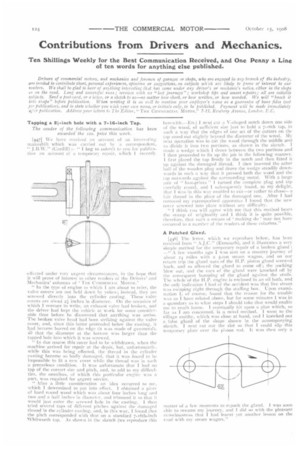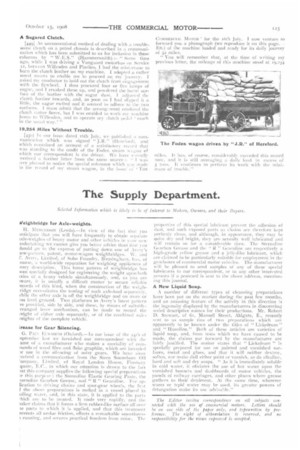Contributions from Drivers and Mechanics.
Page 28

Page 29

If you've noticed an error in this article please click here to report it so we can fix it.
Ten Shillings Weekly f or the Best Communication Received, and One Penny a Line of ten words for anything else published.
Drivers of commercial motors, and mechanics and foremen of garages or shops, who are engaged in any branch of the industry, are invited to contribute short, personal experiences, opinions or suggestions, on subjects wh'ch are likely to prove of interest to our readers, We shall be glad to hear of anything interesting thlt has come under any driver's or mechanic's notice, either in the shops or on the road. Lon.g and successful runs ; services with no "lost journeys" ; workshop tips and smart repairs; all are suitable sabjerts. Send a post-card, or a letter, or a sketch to us—no matter hotel short, or how written, or how worded. We will "knock it into shape" before publication. When writing it is as well to mention your employer's n.nne as a guarantee of bona fides (not ler publication), and to state whether you wish your own name, or initicrs only, to be published. Payment will be made immediately aper publication. Address your letters to The Editor," T1412. CONIsmacrm, lslotoa," 7-75. Rosebery Avenue, London, E.G.
Tapping a 21-inch hole with a 7.-16-inch Tap.
The sender of the following communication has been awarded the zos. prize this week.
14471 We have received an account of LU interesting makeshift which was carried out bya correspondent, J.B.W." (Cardiff) :" I beg to submit to vou for publication an account of a temporaryrepair, which I recently 4-ditcted under very urgent circumstances, in the hope that it will prove of interest to other readers of the Drivers' and Mechanics' columns of ' Tub: CommEvel.n. MOTOR.'
" In the type of engine to which I am about to refer, the valve covers are not held down by yokes; instead, they arc screwed directly into the cylinder casting. These valve -covers are about 21 inches in diameter. On the occasion of which I venture to write, an exhaust valve had broken, and the driver had kept the vehicle at work for some considerable time before he discovered that anything was amiss. The broken valve head had been striking against the valve cover, and, since this latter protruded below the casting, it had heroine burred on the edge tit was made of g,unmetolli, s-Zi that the diameter at the bottom was larger than the tapped hole into which it was screwed, " In due course this cover had to be withdrawn, when the -machine arrived for repair at the depOt, but, unfortunately, while this was being effected, the thread in the cylinder casting became so badly damaged, that it was found to be impossible to lit a new cover while the thread was in such a precarious condition. It was unfortunate that I had no tap of the correct size and pitch, and, to add to my difficulties, the omnibus, of which this particular engine, was a part, was required for urgent service.
" After a little consideration an idea occurred to me, which I determined to put into effect. I obtained a picce -of hard round wood which was about four inches long and two and a half incises in diameter, arid trimmed it so that it would just enter the screwed hole in the casting. I then tried several taps of different pitches against the darniti.t-ed thread in the cylinder casting, and, in this way, I found that The pitch corresponded with that on a standard 7-16th-inch Whitworth tap. As shown in the sketch (we reproduce this herewith.—En.) I next cut a V-shaped notch down one side of the wood, of sufficient size just to hold a 7-Mth tap, in such a way that the edges of one set of the cutters on the trip stood out slightly beyond the diameter of the wood. iNly next operation was to cut the wood through the middle and to divide it into two portions, as shown in the sketch. I inude a wedge which I drove between the two portions and I then proceeded to fix up the job in the following manner. I first placed the tap firmly in the notch and then fitted it up against the damaged thread. I then inserted the other half of the wooden plug and drove the wedge steadily downwards in such a way that it pressed both the wood and the tap outwards against the surrounding metal. With a large pair of " foot-prints " I turned the complete plug and tap carefully round, and I subsequently found, to my delight, that I was in this way enabled to cut—or rather to chase--ti fair thread in the place of the damaged one. After I had removed iiiv extemporised apparatus I found that the new cover screwed into place without any difficulty.
" I think vou will agree with me that this method bears the stamp of originality and I think it is quite possible, therefore, that such a means of making do ' may not have occurred to a number of the readers of these columns."
A Patched Gland.
[448I The letter, m-hich we reproduce below, has been received from " (Exmouth), and it illustrates a very simple method for the temporary repair of a broken gland : —" A few months ago I was sent on a country journey of about 24 miles with a 5-ton strain wagon, and on our return trip the gland nuts of the H.P. piston gland screwed back, and so allowed the gland to come off ; the packing blew out, and the ears of the gland were knocked off by the consequent bumping, of the gland against the studs. The whole of the H. P. engine is enclosed in an oil bath, and the only indication I had of the accident was that live steam was escaping right through the staffing box. Upon examination I, of course, found that the reason for the trouble was as I have related above, but for some minutes L Was in a quandary as to what steps I should take that would enable no to reach home. I eventually hit upon a plan which, so far as I am concerned, is a novel method. I went to the village smithy, which was close at hand, and I knocked out a false gland of the shape shown in the accompanying sketch. I next cut out the slot so that I could slip this temporary plate over the piston rod. It Was then only a A Sugared Clutch.
[449] An unconventional method of dealing with it troublesome clutch on a petrol chassis is described in a communication which has been submitted to us for inclusion in these columns by " \V. ES.'' (Hammersmith) :—" Son(, time ago, while I was driving a Vanguard motorbus on Service 12, between Willesden and Pimlico, I had the misfortune to burn the clutch leather on my machine. I adopted a rather novel means to enable tne to proceed on my journey. I asked my conductor to hold out the clutch from engagement with the flywheel. I then procured four or five lumps of sugar, and I crushed these up, and powdered the burnt surface of the leather with the sugar dust. I ndjueted the clutch further inwards, and, as 5oon as. I had slipped it a little, the sugar melted and it seemed to adhere to the two surf:ices. I must adroit that the arrangement rendered the clutch either fierce, but I was enabled to work mv netehine home to Willesden, and to operate iny clutch pedel nmeh in the tieted way.l "
19,254 Miles Without Trouble.
[4.5o1 In our issue dated teth July, we published ii comriunicatien which was signed " J.R." (Hereford), and which eon I :lined an account of a satisfactory record that was standing to the credit of the Foden steam wee'on of which our correspondent is the driver. We have te rently vceived :t further letter from the saute source :"I was 7ery pleased to notice the special reference which veu made
to the record of my steam wagon, in the issue "hie Commertmee ele toe ' for the trith July. I now venture to forward you a photograph (we reproduce it on this page.En.) of the machine loaded and ready for its daily journey of 52 miles. " You will remember that, at the time of writing my previous letter, the mileage of this machine stood at 19,254
The Foden wagon driven by "J.R." of Hereford. miles. It has, of course, considerably exceeded this record now, and it is still averaging ae 1
a..y load in excess of 5 tons. It continues to perform its work with the minimum of trouble."






























